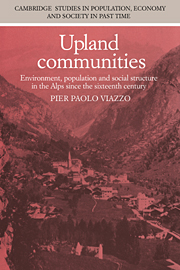 Upland Communities
Upland Communities Published online by Cambridge University Press: 13 October 2009
The medieval colonization of the high valleys
Current debates among ecological anthropologists clearly indicate that a shift from a synchronic to a long-term analysis of the relationships between environment and population is increasingly perceived as a crucial and urgent task. As Emilio Moran has recently remarked, a major limitation of ecological anthropology (and a rather paradoxical one, in view of the importance of the concept of ‘population’ in ecosystemic research) is that ‘ecological anthropological studies have only rarely explored the changing population variable over time’. The remedy, Moran has argued, can only be ‘an extension of the tools of ecological study to include also the tools of historical demography’.
That such an extension of method and theory can mark a very significant advance in ecological anthropology is, indeed, one of the main contentions of this book. But there is a fundamental problem which cannot be overlooked, namely that even in Europe demographic series usually go back for at most three or four centuries. In the case of the Alps, as we shall see, we are reasonably well informed about the period between 1700 and 1850, and for a few localities some data are available also for the sixteenth and seventeenth centuries. Moreover, useful information about the late Middle Ages can be gleaned from the historical literature, especially as far as settlement expansion is concerned. The penetration of the Alpine region by man, however, started some 100,000 years ago, and for this vast time span we can only rely on scanty and largely inadequate archaeological evidence.
To save this book to your Kindle, first ensure [email protected] is added to your Approved Personal Document E-mail List under your Personal Document Settings on the Manage Your Content and Devices page of your Amazon account. Then enter the ‘name’ part of your Kindle email address below. Find out more about saving to your Kindle.
Note you can select to save to either the @free.kindle.com or @kindle.com variations. ‘@free.kindle.com’ emails are free but can only be saved to your device when it is connected to wi-fi. ‘@kindle.com’ emails can be delivered even when you are not connected to wi-fi, but note that service fees apply.
Find out more about the Kindle Personal Document Service.
To save content items to your account, please confirm that you agree to abide by our usage policies. If this is the first time you use this feature, you will be asked to authorise Cambridge Core to connect with your account. Find out more about saving content to Dropbox.
To save content items to your account, please confirm that you agree to abide by our usage policies. If this is the first time you use this feature, you will be asked to authorise Cambridge Core to connect with your account. Find out more about saving content to Google Drive.